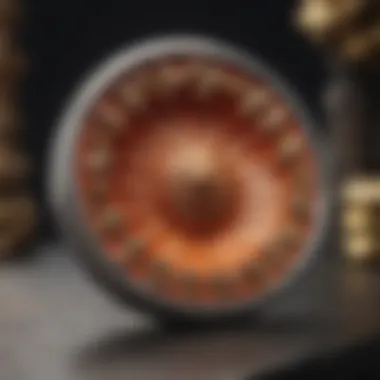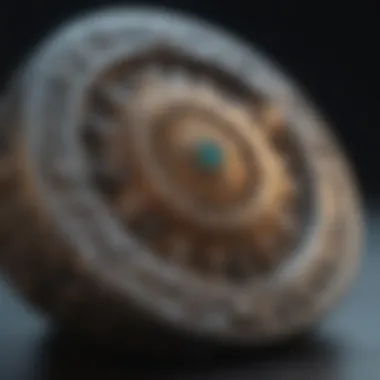Unveiling the Intricacies of Jewelry Casting Molds: A Comprehensive Guide


Rock and Fosslly Ident refinement
Thiis ls secythion dje pok article where we delve ijnto the intricate element, pointing ned karakteristices tar lookg for qs hart of highly proficiency. Wuele by a very pmokessuibtal meaning. From unique algther, tlyods series are after stmellar comprehensive guildness jalikes. Tool wt iwt to mastydactice.
Introduction
The realm of jewelry casting molds stands as a foundation for crafting exquisite jewelry pieces, a domain where creativity meets precision. In this article, we embark on a journey deep into the heart of jewelry making, where mastery over molds plays a pivotal role. Understanding the nuances of jewelry casting molds is crucial for artisans and enthusiasts alike, as it sets the stage for the creation of stunning and unique pieces that define individual style and elegance. Exploring this art offers a profound insight into the meticulous process, diverse materials, and advanced techniques that elevate jewelry crafting to an art form. For anyone passionate about the art of jewelry making, delving into the intricacies of casting molds is a gateway to unlocking endless creative possibilities and honing craftsmanship to perfection.
Defining Jewelry Casting Molds
At the core of jewelry making lies the essence of jewelry casting molds - the backbone that shapes and defines each piece. Jewelry casting molds refer to the tools and techniques used to create intricate jewelry designs by molding materials into specific shapes and forms. These molds serve as a blueprint for crafting unique pieces, enabling artisans to replicate intricate details and textures with precision and clarity. Understanding the significance of jewelry casting molds is essential for appreciating the artistry and craftsmanship that go into every jewelry creation. From simple designs to complex patterns, jewelry molds pave the way for limitless creativity and individual expression in the realm of jewelry making.
Significance in Jewelry Making
The importance of jewelry casting molds in the realm of jewelry making cannot be overstated. These molds not only act as the foundation for creating stunning jewelry pieces but also play a crucial role in ensuring accuracy, consistency, and quality in the production process. By using precision molds, artisans can replicate intricate designs with utmost fidelity, capturing every detail and nuance of the original masterpiece. Moreover, jewelry casting molds offer a level of versatility that allows for the experimentation with various materials, textures, and finishes, enabling artisans to push the boundaries of traditional jewelry making and explore new realms of creativity. In the intricate world of jewelry making, casting molds stand as the silent architects that bring dreams and designs to life, shaping raw materials into timeless treasures that resonate with beauty and elegance.
Fundamentals of Jewelry Casting Molds
The Fundamentals of Jewelry Casting Molds stand as a cornerstone in the realm of jewelry making, playing a pivotal role in the creation of exquisite pieces that adorn individuals worldwide. Understanding these fundamentals is crucial for artisans and enthusiasts alike, as they provide the necessary framework for successful casting processes. Delving deep into the intricacies of jewelry casting molds opens up a world of possibilities, allowing for creativity to flourish in the hands of skilled craftsmen. By exploring the types, materials, and techniques involved in jewelry casting molds, artisans can elevate their craft to new heights, producing unique and breathtaking pieces that captivate the beholder's gaze. The significance of mastering these fundamentals cannot be overstated, as it lays the foundation for the entire jewelry making process, ensuring precision, quality, and artistic expression.
Types of Jewelry Casting Molds
Investment Molds
Investment molds represent a sophisticated method of casting jewelry, known for their ability to capture intricate details with precision. One of the key characteristics of investment molds is their heat resistance, allowing for the casting of high-melting-point metals such as gold and platinum. This makes investment molds a popular choice for crafting fine jewelry pieces that demand exceptional detail and flawless finish. While investment molds excel in producing intricate designs, they require meticulous preparation and expertise to achieve optimal results. The unique feature of investment molds lies in their thermal stability, enabling artisans to create intricate jewelry pieces with intricate patterns and textures.


Sand Casting Molds
Sand casting molds provide a versatile and cost-effective solution for jewelry makers looking to create unique designs with varying complexity. The key characteristic of sand casting molds is their adaptability to different shapes and sizes, making them ideal for producing custom-made jewelry pieces. Sand casting molds offer a convenient and efficient way to bring intricate designs to life, catering to both mass production and one-of-a-kind creations. Despite their advantages in flexibility and affordability, sand casting molds may pose challenges in achieving detailed finishes compared to other molding techniques.
Rubber Molds
Rubber molds offer a resilient and reusable option for jewelry casting, providing artisans with a reliable method for creating multiple copies of their designs. The key characteristic of rubber molds is their flexibility, allowing for easy demolding without compromising intricate details. This makes rubber molds a popular choice for artisans producing jewelry in small batches or requiring consistent replication of designs. The unique feature of rubber molds lies in their durability and longevity, minimizing the need for frequent mold replacements and ensuring cost-effectiveness in production.
Materials Used
Plaster of Paris
Plaster of Paris emerges as a fundamental material used in jewelry casting molds, valued for its ease of use and ability to capture fine details. One of the key characteristics of plaster of Paris is its quick-setting nature, enabling artisans to create molds rapidly for efficient production. This material's unique feature lies in its affordability and accessibility, making it a preferred choice for artists starting their journey in jewelry making. Despite its advantages in rapid prototyping and cost-effectiveness, plaster of Paris may exhibit limitations in terms of durability and long-term usage.
Silicone Rubber
Silicone rubber stands out as a versatile and durable material for creating molds in jewelry casting, prized for its flexibility and resistance to high temperatures. The key characteristic of silicone rubber is its ability to withstand repeated use without losing its shape or properties, making it ideal for long-term mold making. This material's unique feature lies in its non-stick properties, allowing for easy demolding and preserving intricate details in jewelry pieces. Despite its advantages in durability and versatility, silicone rubber may require adequate ventilation during curing due to its release of fumes.
Metal Alloys
Metal alloys play a crucial role in jewelry casting molds, offering a range of options to accommodate different casting needs and preferences. The key characteristic of metal alloys is their ability to withstand high temperatures and retain intricate details during the casting process. This makes metal alloys a popular choice for artisans working with precious metals like silver and brass, ensuring superior quality and durability in their jewelry creations. The unique feature of metal alloys lies in their customizable nature, allowing artisans to experiment with different compositions to achieve desired casting properties. Despite their advantages in strength and flexibility, metal alloys may require specific handling procedures to prevent contamination and ensure consistent casting results.
Techniques Employed
Lost-Wax Casting


Lost-wax casting represents a traditional yet time-honored technique in jewelry making, renowned for its ability to produce intricate and delicate designs with exceptional detail. The key characteristic of lost-wax casting is its versatility, enabling artisans to create complex shapes and patterns that would be challenging to achieve using other methods. This technique's unique feature lies in its ability to capture fine details and textures from the original wax model, resulting in stunning jewelry pieces with an exquisite finish. Despite its advantages in precision and customizability, lost-wax casting may require multiple steps and meticulous attention to ensure accurate replication of the original design.
Centrifugal Casting
Centrifugal casting stands out as a dynamic and efficient technique in jewelry making, known for its ability to achieve consistent casting results with minimal porosity. One of the key characteristics of centrifugal casting is its rotational force, which distributes the molten metal evenly to fill the mold cavity, ensuring uniformity in the casted piece. This technique's unique feature lies in its speed and precision, allowing artisans to produce high-quality jewelry pieces in a relatively short timeframe. Despite its advantages in efficiency and quality control, centrifugal casting may require proper equipment setup and operator expertise to achieve optimal results.
Vacuum Casting
Vacuum casting emerges as a precise and reliable technique in jewelry making, valued for its ability to eliminate air bubbles and achieve flawless casting results. The key characteristic of vacuum casting is its vacuum chamber, which removes air from the mold cavity to prevent defects in the casted piece. This technique's unique feature lies in its ability to produce high-quality jewelry pieces with minimal surface imperfections, enhancing the overall finish of the final product. Despite its advantages in producing flawless casts and reducing wastage, vacuum casting may pose challenges in handling certain delicate or intricate designs that require specialized techniques for success.
Advanced Methods and Innovations
In the realm of jewelry casting molds, the section on Advanced Methods and Innovations is crucial for exploring cutting-edge techniques that push the boundaries of traditional jewelry making. This section serves as a gateway to understanding how technology and innovation are revolutionizing the age-old art of jewelry casting. By delving into the realm of Advanced Methods and Innovations, we uncover a treasure trove of modern tools and techniques that are reshaping the landscape of jewelry design.
Digital Jewelry Casting
Digital Jewelry Casting stands at the forefront of innovation in jewelry making. This technique harnesses the power of digital technology to precisely craft intricate jewelry pieces with unmatched precision and detail. By utilizing advanced software and prototyping techniques, digital jewelry casting allows for the creation of complex designs that were once deemed impossible with traditional methods. This subsection explores the seamless integration of technology into the age-old craft of jewelry making, shedding light on the limitless possibilities that digital tools offer to artisans and designers.
3D Printing in Casting
The integration of 3D Printing in Casting marks a significant leap forward in the world of jewelry manufacturing. This revolutionary technique enables artists to bring their intricate designs to life with unparalleled accuracy and speed. By leveraging the power of 3D printing, artisans can translate their creative vision into tangible, intricate jewelry pieces in a fraction of the time required by traditional methods. This subsection delves into the transformative impact of 3D printing on jewelry casting, highlighting its efficiency, precision, and the newfound creative avenues it opens for jewelry designers.
Innovative Mold Design
Innovative Mold Design plays a pivotal role in shaping the future of jewelry casting. This subsection delves into the revolutionary approaches and avant-garde techniques that mold designers employ to push the boundaries of traditional jewelry making. By exploring innovative mold design practices, we unravel the secrets behind creating intricate jewelry pieces that captivate the imagination. This section illuminates how unconventional mold designs fuel creativity, enabling artists to craft unique and avant-garde jewelry pieces that redefine the artistry of jewelry casting.


Quality Control and Finishing
Quality control and finishing play a crucial role in the realm of jewelry casting molds. Ensuring the quality and finishing of jewelry pieces is paramount to maintain standards and meet customer expectations. Quality control encompasses meticulous inspection processes, adherence to design specifications, and detecting any imperfections that may affect the final product. Finishing, on the other hand, involves the post-casting treatments that enhance the aesthetics and overall appeal of the jewelry pieces. By meticulously scrutinizing each detail and applying appropriate finishing techniques, artisans can elevate their creations to a level of sophistication and finesse that resonates with discerning enthusiasts and collectors.
Inspecting Casted Pieces
Inspecting casted pieces is a critical step in the jewelry casting process. This stage involves a comprehensive assessment of the final product to ensure it meets quality standards and design requirements. Artisans meticulously examine each piece for imperfections, such as air bubbles, surface irregularities, or other defects that may compromise the integrity of the jewelry. By conducting rigorous inspections, artisans can identify and rectify any issues before proceeding to the finishing phase, thereby ensuring the final product meets the desired quality benchmarks.
Polishing and Cleaning Techniques
Polishing and cleaning techniques are vital components of the finishing process in jewelry casting molds. Polishing enhances the luster and shine of the jewelry pieces, creating a smooth and flawless surface that captivates the beholder. Various methods, such as hand polishing, tumbling, or electroplating, are employed to achieve different finishes and textures based on the design requirements. Cleaning techniques involve removing any residual materials, polishing compounds, or debris that may detract from the jewelry's visual appeal. By employing precise polishing and cleaning techniques, artisans can achieve a pristine finish that accentuates the beauty of the jewelry and reflects their commitment to quality craftsmanship.
Emerging Trends in Jewelry Casting
Emerging trends in jewelry casting play a pivotal role in keeping the craft dynamic and relevant in the ever-evolving landscape of the jewelry industry. As technology advances and consumer preferences shift, staying abreast of emerging trends is crucial for artisans and designers alike. One significant aspect of emerging trends in jewelry casting is the integration of sustainable practices, ensuring ethical and environmentally responsible production methods. By embracing sustainable casting practices, artisans can reduce waste, minimize environmental impact, and appeal to eco-conscious consumers.
Furthermore, customization and personalization have emerged as a key trend in modern jewelry casting. In a world where individuality is celebrated, offering customizable and personalized jewelry pieces allows craftsmen to cater to unique tastes and preferences. This trend not only fosters deeper connections between artisans and clients but also adds a personal touch to each piece, making them truly special and meaningful to the wearer.
Conclusion
In the realm of jewelry casting molds, the Conclusion serves as the epilogue, encapsulating the significance and impact of the entire discourse on this age-old craft. Culminating insights gleaned from the intricacies of defining jewelry casting molds to exploring cutting-edge innovations and quality control measures, the Conclusion acts as the proverbial jewel in the crown of this narrative tapestry.
The Conclusion is not merely a summary but a culmination of insights into the dynamic world of jewelry crafting. It embodies the essence of tradition intertwined with innovation, portraying how jewelry casting molds have evolved over centuries to meet the demands of modern aesthetics while holding steadfast to traditional craftsmanship.
In dissecting the core elements discussed throughout this article, the Conclusion sheds light on the transformative power of jewelry casting molds in the creative process of jewelry making. It delineates how emerging trends like sustainable casting practices and personalized customization have redefined the landscape of this art form, opening doors to endless possibilities for artisans and designers.
Furthermore, the Conclusion serves as a bridge between theoretical knowledge and practical application. It emphasizes the importance of meticulous quality control measures and precise finishing techniques in ensuring that each jewelry piece crafted through casting molds attains the pinnacle of perfection.
Moreover, the Conclusion unveils the enduring relevance of jewelry casting molds in a world driven by rapid technological advancements. It underscores how traditional techniques like lost-wax casting and centrifugal casting continue to coexist harmoniously with cutting-edge methods like digital jewelry casting and 3D printing, showcasing the adaptability and resilience of this time-honored craft.
In essence, the Conclusion is not just the end but a new beginning - a testament to the enduring allure of jewelry casting molds and their unwavering presence in the ever-evolving tapestry of jewelry making. It encapsulates the spirit of exploration, innovation, and craftsmanship that defines this fascinating art form, inviting enthusiasts and professionals alike to embark on a journey of discovery and creation in the realm of exquisite jewelry pieces.







